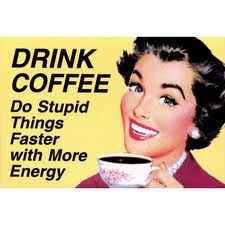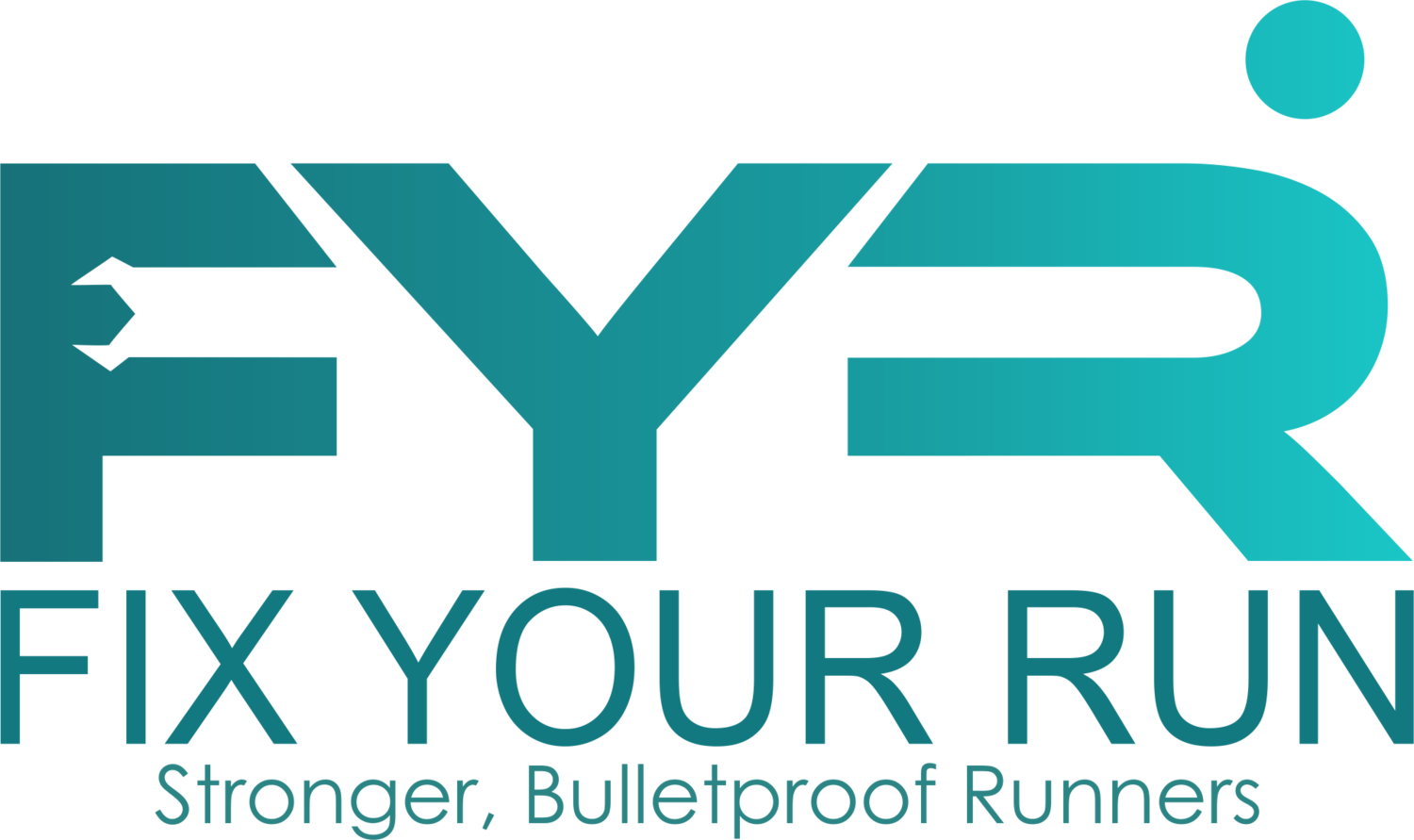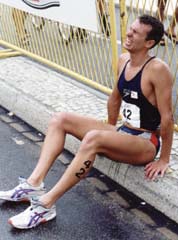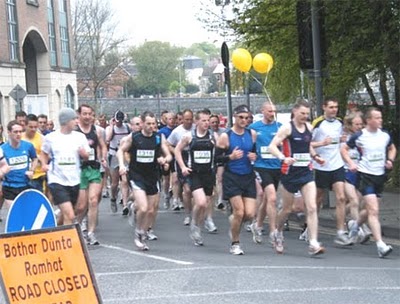What do running websites put out in terms of nutritional advice and content? Is it current? Or do they perpetuate the same old school advice that people have heard for years? Since a lot of people attempt to use running as a way to lose weight, it's important to make sure your dietary habits support your goals. So what's the deal with carbs??
Spreading the Truth About Running and Fat Loss - Part 2
Spreading the Truth About Running and Fat Loss
Do You Have A Flat Tire?
 As I mentioned last week, I had the privilege of speaking to group of inspiring women who are nearing the end of their journey through Precision Nutrition's Lean Eating program. The program, although set up as a competition, aims to gradually and methodically transform one's lifestyle into one that supports good health, performance and body composition. This is no “diet plan”, trust me. It's WAY better than that.
As I mentioned last week, I had the privilege of speaking to group of inspiring women who are nearing the end of their journey through Precision Nutrition's Lean Eating program. The program, although set up as a competition, aims to gradually and methodically transform one's lifestyle into one that supports good health, performance and body composition. This is no “diet plan”, trust me. It's WAY better than that.
These participants have been training all year and have achieved some incredible results, but my goal was to give them an opportunity to reach the next level. Understanding how you need a large base of mobility and stability to SUPPORT all of that necessary training was likely a new concept for these folks. It is for most people.
In today's instant gratification society, we want results NOW. We want a hard workout, perhaps someone to shout at us and get us fit. There is typically next to zero appreciation for actually taking the time to learn to move properly. Nah, we'd rather jump right into a Zumba class (did I just admit that?) and throw fitness smack on top of our dysfunctional movement patterns.
Thanks to a culture that promotes SITTING as a way of life we're acquiring dysfunction everyday. Sure, you can get fit. But, at some point you'll call me complaining about your knee or back problem while blaming your genetics!
People who score below a certain point on a movement screen are at a much greater risk for non-contact injuries. It's just a matter of time. The audience at the gathering had done a kick ass job of training, but to reach the next level of strength, leanness, endurance, performance, etc. they need to know what's holding them back the most.
The day following my talk I guided 13 individuals through a Functional Movement Screen. I found the results fascinating. Out of 13 people, 10 had the same weak link: an inability to perform the Trunk Stability Push-Up.
In other words, when I instructed them to perform a push-up from the floor,  instead of pushing off the ground as a single unit, their upper body lifted and their hips sagged behind. This means that natural reflexive core stabilization has been lost. When your hands sense all that bodyweight pressure as you start to push off, a reflex should kick in and cause your core to tighten appropriately before lift-off can occur.
instead of pushing off the ground as a single unit, their upper body lifted and their hips sagged behind. This means that natural reflexive core stabilization has been lost. When your hands sense all that bodyweight pressure as you start to push off, a reflex should kick in and cause your core to tighten appropriately before lift-off can occur.
The consequence of losing this particular pattern is that you become inefficient and waste energy. It's like driving around with a flat tire! And if you have no idea this is going on you'll just keep training, not fully realizing your potential.
Think about it. You could be burning more calories during each workout. You could be running with less effort. If you play golf or tennis, your game may very well improve. I won't go so far as to guarantee a better sex life, but feel free to write a testimonial for me if it improves. :-)
Wanna find out if YOU have a flat tire? Wanna know where it is ...and how to fix it? Stay tuned for an upcoming announcement regarding a special movement screening offer!
PS: To gauge interest, please send me a quick note with the words “FMS Interested” in the subject line.
My Top 10 Movement Tips
3 Common Problems with Your Run
What Are Your Rocks?
A professor stood in front of a class told his students to prepare for a pop quiz about time management. He then proceeded to pull out a big jar and place it on his desk. He then gently placed about a dozen large rocks into the jar one by one. When he ran out of space in the jar to place any more rocks inside he asked the class: ‘is the jar full?’
The Key To Marathon Success
If you're training for the Philly Marathon, then most likely you're in the midst of your heaviest training load right now. Putting the hay in the barn, as they say.

In only 2 weeks it really won't matter how much you train because the training window will have shut on your ability to build endurance for the race. At that point it's time to simply maintain intensity while cutting back on mileage and it's usually called “tapering” or “peaking”. This is one test you can't cram for!
Back to the present for a second, though. If you haven't already, it might be a good time to start thinking about your pacing strategy for the race. Most experienced marathoners will agree that this is usually the single biggest mistake made during a marathon. The consequences of poor pacing, which means running too fast in the early miles, include:
- Cramping
- Bonking (hitting the wall)
- Losing Good Running Form
- Definitely NOT hitting your goal time
Today we know not to blame the following factors on a lousy finish:
- Dehydration
- Electrolyte Imbalance (not enough salt)
It turns out dehydration and electrolyte imbalance are not the limiting factors they were once thought to be. As long as you drink to thirst you will most likely finish the race strong, given good pacing. Sure, you will finish the race LESS hydrated than when you started, but your performance will not decline because of it until you lose 2% or more of your bodyweight. So stop worrying about drinking at every single water station and start tuning in to your thirst mechanism. It's been refined for about a million years.
So it usually comes down to pacing and the question arises:
How do you know what pace to run?
The answer is that you will usually do well to base your pacing off of a recent race performance. A hard time trial or race within 6 weeks of your marathon will give you the most specific guidance when determining your optimal marathon race pace.
Plug your 5K to Half Marathon time into a running calculator to get the appropriate pace.
This is a pretty accurate way to figure out your pace, BUT... you must be specifically training hard for a marathon in order for this method to work. You can't just train 30 miles or run 5 hours per week and expect to run your best marathon.
Let me re-phrase that. Just because you ran a 5K last weekend in 22 minutes doesn't automatically mean you can go run a marathon in it's equivalent time of 3:34. Nope. 3:34 indicates your potential IF you are training optimally for the marathon.
In my experience, many people don't actually put in enough mileage to be optimally
trained. This is where the problem arises. People overestimate their fitness and go into the marathon with a bad pace strategy from the beginning.
In addition to an all-out race effort, one idea that's proved useful for my clients and I has been to run a 'race simulation'. This session, which tends to give you really valuable information and confidence, should be done about 3-4 weeks out from race day. About two easy days should precede the following session:
- Run Easy for 3 miles
- Run Marathon Goal Pace for 13 miles
- Run Easy for 2 miles
During and after the run you'll gain a sense for how strong you really are and if the pace seems reasonable.
Don't forget to take a gel every 35-40 minutes during the run. It is vital that you do ingest carbohydrate during the race – but that's a post for another day. Suffice it to say, you definitely want to practice this before race day as it appears that one can actually train the gut to absorb more calories than an 'untrained gut'.
So to summarize, the one thing you don't want to screw up is your pacing. Yes, it will take discipline and patience like I've said in the past. Expect it to feel easy – maybe even too easy – in the first 8-10 miles. That's perfect. You'll pass 'em all later!
PS: For those of you who have read this far and are running a marathon soon, you'll definitely want to check out coach Greg McMillan's marathon tips for pre- and post-race.
PPS: For a more comprehensive review on pacing, check out http://www.sportsscientists.com/2008/01/fatigue-examined.html
Wear THIS, not THAT
Getting Lean Vs. Staying Lean
As many of my clients have heard me say, “getting lean” and “staying lean” are two completely different things. Getting lean is like going on a trip. You get a map and you set off on a trip from point A to point B. Sure, you may encounter a few detours along the way, but generally you know where you're headed and you have a plan. It's often not easy, but if you just stay the course, you'll get there. So what happens when you arrive?
Deformed Feet Aren't Sexy
Be An Athlete First and a Runner Second
Remember Tangents?
As I cheered on many of my clients and friends at the Rock and Roll Philadelphia Half Marathon, I noticed something. In fact, it really puzzled me. With about 1/2 mile to go, most runners were (understandably) struggling to get to the finish line. The weird thing was, after running almost 13 miles all out, thousands runners were choosing to run farther than necessary!
Random Thoughts and Stuff
How Well Do You Respond To Training?
A few minutes into lunch she revealed her real goal: qualifying for the Boston Marathon. And she didn't mean eventually. She wanted to qualify AT Marine Corps. This after telling me she'd just run Broad Street in 1:26, or close to the same pace she'd have to maintain for 26.2 miles. Would this be possible?
Stay Above The Line
Lift Like A Distance Runner
In endurance sports we tend to get carried away with improving our engine, our aerobic capacity. But isn't it also how much force you can direct into the ground? When you run, you are fighting gravity. That is where the majority of our energy goes. The better equipped you are to fight gravity, the better you will run.
I'm Officially Inspired
Race Recap
Stifling sprint work.
Heavy deadlifting.
Clean nutrition (except for, like, 3 trips in 4 days to Ben & Jerry's while in Lake Placid, oops).
Constant hydration.
Good sleep habits (well, I tried).
Daily foam roller molestation...
I'm happy to report the past two months of training has paid off!
The USA Track & Field Masters National Championships were held in scenic Berea, Ohio (15mi southwest of Cleveland) on Sunday under bright sunshine and calm winds.
Coming into the race my personal best time for 1500m (a mile is 1609m) was 4:29.82 set on June 12 this year and, considering how well the past 6 weeks have gone, I set a goal of running 4:25. To do that, I'd need to really nail my pacing while expending as little energy as possible in the first 2 laps.
The tricky thing about these races is not knowing how everyone else will run. Ideally, in any race, you run directly behind someone for as long as possible before passing them. This produces a drafting effect that can save you a significant amount of energy. Would anyone run the pace that's right for me and do all the work for me?
For the first few laps that's exactly what happened. I tucked in behind a few guys and got off to a great start. My first and second laps were faster that any other race I'd ever run, but I was feeling strong and the drafting effect was working like a charm.
I sensed the guy in front of me starting to slow and, since I was still feeling 'good', decided to push on. I didn't have much of a chance of reeling in the top 3 runners - they were a bit out of my league - but I was on pace to get my goal time and wasn't about to let the opportunity slip away by staying comfortable.
The whole point of spending a summer weekend in, ahem, Berea, Ohio was to suffer for a little longer than 4 minutes. No coulda, shoulda or woulda!
As I rounded the last turn, the rather sparsely populated crowd began cheering louder and louder. Someone who I thought I'd left behind had started gaining on me. The thought of looking behind me never crossed my mind out of fear I wouldn't like what I'd see so I just tried my best to sprint as hard as I could for the finish line.
He couldn't quite catch me and I exceeded my goal!!! Ran 4:23.26 and totally surpassed my expectations!
Check out the vid here. The announcer kept misidentifying me as the leader in the first lap and a half which was actually kind of motivating!! And I'll be the first to admit that I need to work on holding form all the way to the line, but that is WAY easier said than done:-) In the moment, you're desperately trying to do whatever it takes...





